

 |
 |
Nilgun Ozdamar Keskin and Abdullah Kuzu
Anadolu University, Turkey
In the present study, a mobile learning system for the professional development of academics was developed by design based action research, and the perceptions and experiences of the academics using this system were examined. In the first phase of this design-based action research, the research question was defined. In the second phase, a m-learning system called “Mobile Academic Research Support” (MARS) was designed as a solution to the problem, and the IOS mobile application for this design was developed. In the third phase of the study, the MARS application was regularly tested and evaluated by the academics over eight weeks. At the end of the research process, the results were reflected upon. It was found that the primary and important professional development needs of the academics were at the scientific research level. It was also observed that the m-learning system developed for the professional development of the academics regarding scientific research was appropriate to the overall purpose, accessible, adaptable and appealing; that it served both as a m-learning and as an academic support system; that its content was satisfactory; and that the tools used in the system were useful. In addition, it was observed that the academics were able to use mobile technologies for learning. Also, it was stated that such a system could provide positive contributions to the professional development of academics.
Keywords: Mobile learning; mobile technologies; design-based research; action research; professional development of academics; performance support; IOS application
In the 21st century, higher education institutions had to be reconstructed to adapt to changes such as the increasing global competition, the growing need for higher education, the changing nature of information, rapid developments in information and communication technologies and the varying expectations and demographic features of learners (Kukulska-Hulme and Traxler, 2007). The changes in the dynamics of information technologies, institutions and learners influence the academics working in higher education institutions. Thus, while trying to develop their academic competencies as well as their knowledge about learners’ characteristics and about current teaching and research approaches, academics, at the same time, make effort to develop their skills in the use of information and communication technologies. This situation constantly forces academics to take part in professional development activities. Mobile devices are appropriate technologies to do research, engage in instructional activities, achieve institutional objectives and conduct new approaches in education (Hamm, Drysdale & Moore, 2014). Mobile technologies, which allow access to information in any place and at any time and which provide learning opportunities while mobile, can be used for professional development purposes (Sharples, 2000). In this respect, a comprehensive analysis of the needs of academics has been proposed in the design of m-learning systems (Kukulska-Hulme, 2013). Following this, an appropriate system can be designed based on current mobile learning (m-learning) approaches and learning theories.
The purpose of the present study was not only to develop a m-learning system to meet the professional development needs of academics but also to examine the perceptions and experiences of academics using the system. In line with this purpose, the following questions were directed in the study:
With the recent developments in technology, there has been a transformation from electronic services to mobile services. The increase in the global use of mobile devices has also accelerated the transformation. According to the statistics provided by International Union of Telecommunication (May, 2014), approximately seven billion people have a contract with a mobile phone operator, and this number is equal to 95.5% of the world population (Mobithinking, 2014). In recent years, there has been a huge increase in tablet computer sales. According to International Data Corporation (IDC) (September, 2013) report, tablet shipments will grow 58.7% in 2013 reaching 229.3 million units, up from 144.5 million units in 2012. IDC predicts the tablet market will outpace the entire PC market (portables and desktops combined) by 2015. By 2016, 282.7 million people are expected to have a 3G tablet. These results demonstrate that people prevalently use mobile devices and that the use of wireless mobile communication technologies – mobile Internet use – is gradually increasing. The transformation, called the mobile era, has influenced all fields including education and caused m-learning to be regarded as a new paradigm of the present day (Traxler, 2009a).
Mobile devices present different learning oppurtunities such as portability, social interactivity, context sensitivity, connectivity, individuality and affordance to people in academic settings or non-academic settings (Crompton, 2013a). M-learning can occur unplanned, spontaneous learning experience or with planned educational program in the schools by using mobile devices (Crompton, 2013). People can determine their own learning path to achieve their learning goal by using their own private mobile device. In addition, m-learning offers situated learning taking place anywhere and at any time of the day as well as personalized learning through applications, concepts, and often the ownership of devices modified for the user (Traxler, 2011).
When the related literature was examined, no consensus emerged on the definitions of m-learning. The initial definitions made for m-learning were technology-based. As for the current definitions of m-learning, they claim that what is important is not the technology itself but situating the learner at the center of learning. Also, these current definitions refer to m-learning as a learning method which allows learners to benefit, regardless of time and place, from the learning opportunities provided by mobile technologies (Q’malley et al., 2003; Parsons, 2007). There are four central constructs in m-learning definitions in the recent studies. These are pedagogy, technological devices, context and social interactions. For example, Sharples’s definition (2007) includes these constructs: “the process of coming to know through conversations across amongst people and personal interactive”. Sharples conducted conversation as interactions generally. However; the conversation in the definition has been misunderstood due to the fact that conversation means verbal communication, the interchange through speech of information, ideas, and so on (Crompton, 2013). Crompton, Muilenburg and Berge developed the Sharples’ definition and defined m-learning as “learning across multiple contexts, through social and content interactions, using personal electronic devices”. It has been observed that this definition has been highly accepted by researchers in the m-learning communities (Ally & Tsinakos, 2014; Crompton, 2013; Hamm, Drysdale & Moore, 2014).
In recent years, researchers have studied the development of the theoretical frameworks of m-learning (Sharples, Taylor and Vavoula, 2005; Uden, 2007; Zurita and Nussbaum, 2007). Mobile education (FRAME) based on activity theory, presented by Koole (2009), is one of the theoretical frameworks for analyzing people’s practices as development processes (Crompton, 2013). Also, it describes m-learning as a process resulting from the convergence of mobile technologies, human learning capacities and social interaction (Koole, 2009). Conversation theory, developed by Pask in 1975, is a new m-learning theory on the construction of knowledge through the exchange of knowledge via pervasive mobile devices (Sharples et al., 2007). Moreover, Park (2011) modified transactional distance education theory for m-learning. He categorized m-learning in distance education as 1) high transactional distance and socialized m-learning, 2) high transactional distance and individualized m-learning, 3) low transactional distance and socialized m-learning, and 4) low transactional distance and individualized m-learning. On the other hand, there are some theoretical approaches based on performance support for m-learning. For example, Gotfredson identifies five moments of learning need as “learning for the first time” and “when wanting to learn more (acquisition of knowledge) as well as “application of knowledge”, “when trying to apply / remember”, “when things goes wrong”, and “when things change” (performance support). According to him, mobile devices meet learning needs of both acquisition of knowledge and performance support. Also, Quinn (2013) claimed that if there is a performance, there is an opportunity for learning as well. He proposed the Four Cs: the consumption of content, interactions with compute capabilities, the ability to communicate with others, and the capture of our context (via video and/or audio, orientation, location, time and increasingly more data) (Quinn, 2013). He stated that the consumption at an appropriate time and in context can be valuable without interaction.
When considering these frameworks, there is still a lack of transferable design frameworks on m-learning (Cochrane, 2013; Sharples, Crook et al., 2009). Practitioners, instructional designers and trainers are in need of design theories regarding not only how to integrate mobile technologies into learning environments in order to achieve more effective learning via mobile technologies but also how to make these technologies more beneficial for users (Koszalka and Ntloedibe Kuswani, 2010; Naismith, Lonsdale, Vavoula and Sharples, 2004; Park, 2011; Rajasingham, 2011; Taylor, 2006).
Examining large scale m-learning projects, the projects basicly focus on devices, learning outside the classroom and mobility of learner (Cochrane, 2014; Cook, 2009; Sharples, 2010). Also, many m-learning studies focus on content delivery for small screen and capabilities of mobile devices for collaborative learning (Cochrane, 2013). According to the results of a study conducted by Frohberg, Göth and Schwabe (2009) to examine the m-learning projects in related literature, among 102 m-learning projects, 89 of them were conducted with new learners; six of them with those who had a low level of background knowledge; and seven with those who had a significant level of background knowledge. In their study, no m-learning project was reported for specialists or for learners who had a high level of background knowledge. In relation to this finding, Frohberg, Göth and Schwabe criticized the m-learning projects they mentioned in their study, and they stated that it would be enough to study new learners as well as on those who have a low level of background knowledge. They further stated that it would always be easier to teach new learners and those who have a low level of background knowledge than specialists and learners who have a high level of background knowledge. On the other hand, there is a need for research on m-learning to be carried out with specialists (for example academics) and learners who have a high level of background knowledge about how to transfer the information and about how to develop the skills better (Frohberg, Göth and Schwabe, 2009).
We believe that cultural change is required for m-learning adoption. Academics in higher education institutions (who are also leaders) may provide the change of m-learning perceptions and lead the cultural transformation. Studies outline the potential use of mobile devices for knowledge sharing among academics in higher education institutions (Handal, MacNish, & Petocz, 2013; Hussein & Nassuora, 2011). However, the studies have highlighted if technological infrastructure, support service and budget problems are solved, academics could adopt and use mobile technologies more for learning (Handal, MacNish, & Petocz, 2013; Menzi, Onal & Caliskan, 2012).
Wingkvist and Ericsson (2009) classified 76 full papers from Mlearn 2007 and Mlearn 2008 according to research methodologies and research purpose. The reviewers found that predominant research was small-scale descriptive case studies with little evaluation and reflection. Action research methodology was used in 5% of these studies. Thus, there is a need for comprehensive and reflective m-learning research that focuses on learners’ particular needs and use new research methodologies. M-learning is an evolving field where researchers could apply various methods to solve their problems (Wingkvist and Ericsson, 2009). Therefore, we studied with “academics” as a target group and used design based action research methodology as a research method in the study.
In an information society, it is necessary for people to be conscious of life-long learning, to adapt themselves to constant development, to be willing to take training on skills they need and to use information and communication technologies effectively. Especially due to the responsibilities of academics for becoming pioneers of change and development, it is a must for them to give priority to their professional development so that they can avoid academic obsolescence. In this respect, it is quite important to determine the professional development needs of academics and to organize learning systems and activities for them. Academics are in need of technologies which will allow them to access the necessary information within the shortest time and which will contribute to the development of their professional skills. Today, mobile technologies are regarded as the most appropriate technologies for professional development of academics thanks to a wide range of opportunities these technologies provide. Academics’ use of mobile technologies and their views about m-learning are quite important to determine their perceptions of m-learning. In addition, due to the high level of competition in the information society, it is also important for universities to keep up with and make use of the developments in information and communication technologies. In this respect, it is necessary to develop m-learning applications for higher education institutions. In this way, experiences shared in the development phase will lead to the development of professional m-learning applications.
In this study, the design-based action research method was applied. Design-based research aims at developing educational practices through systematic and iterative analysis, design, development and implementation, based on cooperation between researchers and practitioners in a real setting, and leading to contextually-sensitive design principles and theories (Wang and Hannafin, 2005). The design-based research process includes four phases: (1) analysis of practical problems by researchers and practitioners, (2) development of solutions within a theoretical framework, (3) the testing and evaluation of solutions in practice, (4) reflection and documentation to produce design principles (Reeves, 2006; Ma & Harmon, 2009, pp. 76-77). The research methodology most appropriate to the third phase is action research (Andriessen, 2007). By allowing repeated development of the product until all the problems identified with the product are overcome in the implementation and testing process, action research can make the product highly effective, efficient and useful (Susman and Evered, 1978). In the last phase, based on the analyses of the data collected in each phase, the design principles and the theory can be developed (Ma and Harmon, 2009). Invaluable information can be obtained regarding both practice and theory (Andriessen, 2007; Livari and Venable, 2009).
Figure 1 demonstrates the design-based action research process adopted in the present study. In this study, a new design-based research model called design based action research model was developed by combining the design-based research model put forward by Ma and Harmon (2009) and the action research cycle suggested by Susman and Evered (1978) regarding information systems.
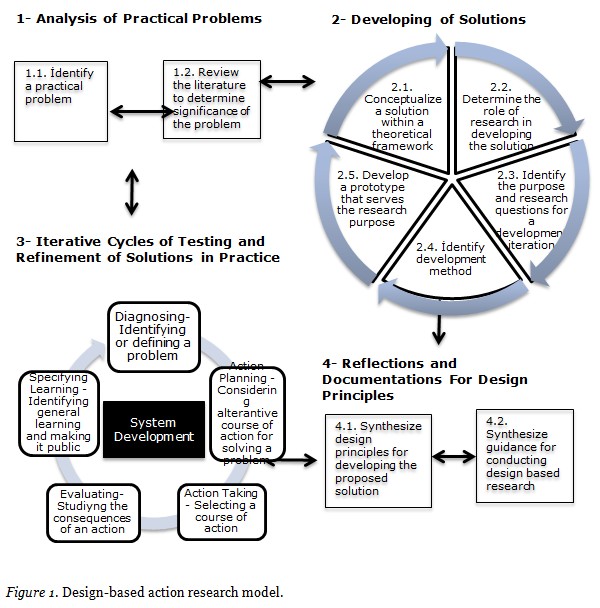
Design based action research model consists of four interactive phases. The first phase is “analysis of practical problems”. In this phase, a practical problem is identified and the related literature about the practical problem is reviewed. The second phase is “developing of solutions”. In the second phase, after solutions for the practical problem are conceptualized, and research purpose and research method are identified, a prototype that serves research purpose is developed. The third interactive and circular phase includes action research methodology based on system development. It is called “iterative cycles of testing and refinement of solutions in practice and reflections”. In the phase, problems related to the prototype are diagnosed and identified. After action plans are prepared to solve the problems, an action is implemented and the consequences of the action evaluated. This continues until all problems are solved. The final phase is “reflections and documentations for design”. In the final phase, design principles are generated and a guidance for conducting design-based research is developed.
Since design-based action research is a multi-phase study, the present study involved more than one study group. The research data were collected from 12 academics participating in the focus-group interviews, 478 academics filling in the questionnaire, the application-development team working on the development of the m-learning system, 15 academics taking part in the action research, the validity committee of the action research and the researcher of the present study. A research diary, focus-group interviews, a questionnaire, semi-structured interviews, e-mails, online documents, personal information form, evaluation form, achievement test, validity committee meeting records and checklists were used as data collection tools in this study.
The phases are listed and the related findings of each phase are presented below.
The first phase of the study is “analysis of the practical problems”. Table 1 presents four research questions linked with study group, research duration, data collection technique, data analysis methods and outcomes related to the first phase.
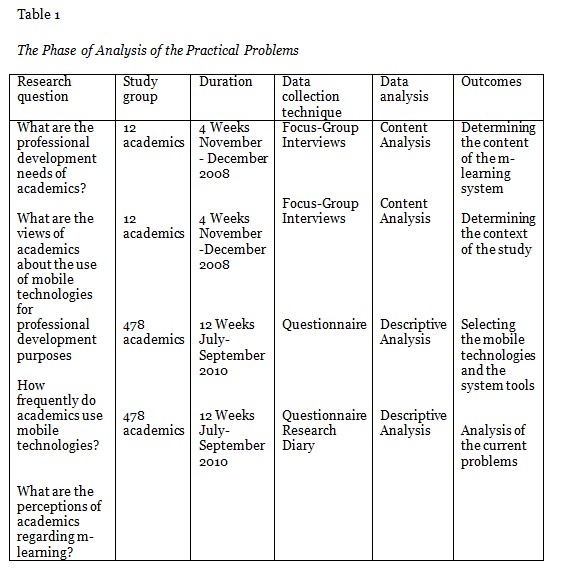
As can be seen in Table 1, for the purpose of determining the practical problem in this study, the academics’ professional development needs, their use of mobile technologies and their perceptions of m-learning were examined. Table 2 presents the themes and sub-themes formed as a result of the content analysis of the data collected from 12 academics (from different departments) participating in the focus-group interviews.
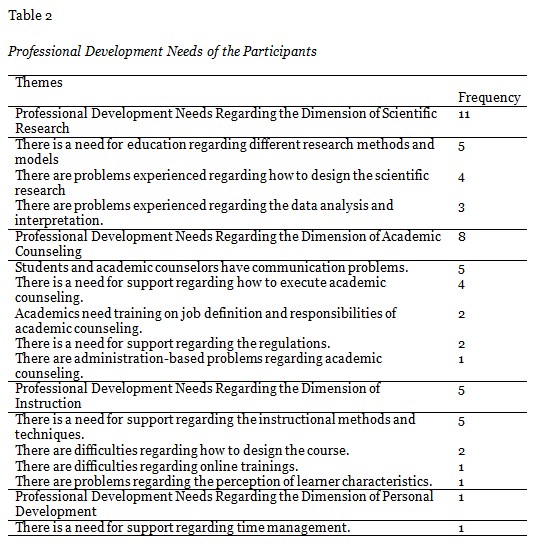
As can be seen in Table 2, the academics had professional development needs with respect to such dimensions as research, teaching, counseling and personal development. Depending on the findings obtained, it could be stated that the academics had professional development needs primarily and necessarily in the dimension of scientific research. The participants reported that they experienced difficulties in choosing and applying appropriate scientific research methods. Below are the views of two of the participants.
“Well, either qualitative or quantitative, although we try to do by getting help for the first time for this part, as the ones who will use it in thesis, we certainly need help about it, we severely have problems about this issue.”
“For instance I do not have too much knowledge about method and data analysis. Thus, there is no problem in research literature. Also, there is no problem in defining the aims but at the phase of analyzing data, external support is necessary. ” [D2]
In order to examine the academics’ use of mobile technologies and their perceptions of m-learning, all the 1,791 academics at Anadolu University were sent a questionnaire, and 478 academics responded to and returned it. It was seen that of all the academics (n=478), only one of them did not use a mobile phone. When the activities the academics carried out via their mobile phones were examined, it was found that the activity they carried out all the time was “speaking”. It was also revealed that the academics frequently used such functions of their mobile phones as the alarm-clock and calendar. When the mobile phones used by the academics were examined, it was seen that of all the academics participating in the questionnaire, 74 of them used a navigation device (15.5%); 60 of them used a portable media player (12.6%); 34 of them used PDA (7.1%); 24 of them used portable gamepads (5%); 22 of them used tablet computers (4.6%); and 12 of them used book-readers (2.5%). These results demonstrated that the academics did not use other mobile devices more than mobile phones. Of all the academics, 35% of them used the mobile Internet. It was seen that they sometimes used the mobile Internet in order to surf on the Internet and to send their e-mail. The findings obtained regarding m-learning as a result of the questionnaire conducted demonstrated that of all the participating academics, 107 of them were knowledgeable about m-learning (22.4%); that 165 of them did not have any knowledge about m-learning (34.5%); and that 206 of them were partly knowledgeable about m-learning (43.1%). Based on this finding, it could be stated that the academics needed training on m-learning. In other words, it could be stated that the academics were in need of m-learning applications that they would be able to use to get knowledgeable about how educational activities were conducted with the use of mobile technologies. In relation to the problems experienced regarding m-learning, the academics reported such difficulties from the most frequent to the least as “high prices of mobile phones” (81.6%), ”high cost of the mobile Internet” (79.9%), “the small sizes of mobile phone screens” (78.9%), “low connection speeds of mobile devices” (68%), “difficulty in using mobile devices” (67.8%), “low capacity of mobile devices” (58.6%), “advanced technology knowledge required” (53.3%) and “high level of self-discipline required” (53.3%). Depending on these findings, it could be stated that the problems experienced frequently by the academics were related to the high cost of mobile devices and of the mobile Internet. Due to this difficulty perceived by the academics, it could be stated that they did not prevalently use mobile devices or the mobile Internet.
The second phase of the study was worked developing the solutions for the problem on mobile research methodology training of academics in Anadolu University. Table 3 presents two research questions linked with study group, research duration, data collection technique, data analysis methods and outcomes.
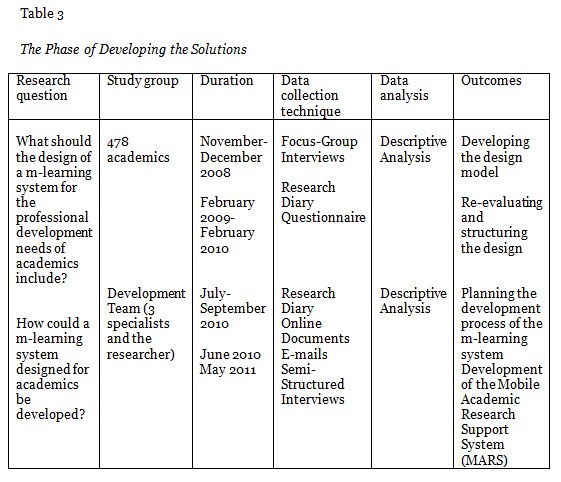
As can be seen in Table 3, the second phase of the design-based action research process examined how to design a m-learning system for the development of a solution by using the technological innovations and the current theoretical framework. During the focus-group interviews, the academics were asked for their views about the design of the m-learning system to be designed for their professional development. The academics reported that the m-learning system designed for their professional development could include up-to-date information, frequently asked questions, checklists, samples, concept maps, academic calendar, reference list and a decision support system.
Based on the findings obtained via the focus-group interviews and the questionnaire, the decision made was that the m-learning system to be developed would be a comprehensive m-learning system that would also include a performance support system. For this purpose, the m-learning system was based on the performance support system, database and learning found in the comprehensive m-learning and performance support model suggested by Metcalf (2005). The components of the performance support system (counseling system, database, teaching system, online help, software supporting productivity and end-user interface) suggested by Gary (1991) were taken into consideration while developing the tools of the m-learning system. As can be seen in Figure 2, the model of Mobile Academic Research System includes the tools of ‘Course’, ‘Online Sources’, ‘Counseling’, ‘Communication’ and ‘Help’. With this m-learning system, the purpose was to provide a m-learning environment which academics could reach via mobile technologies in any place at any time and which would support their professional developments within the context of scientific research. Figure 2 presents the tools found in the first phase of the m-learning system designed as a solution to the current needs.
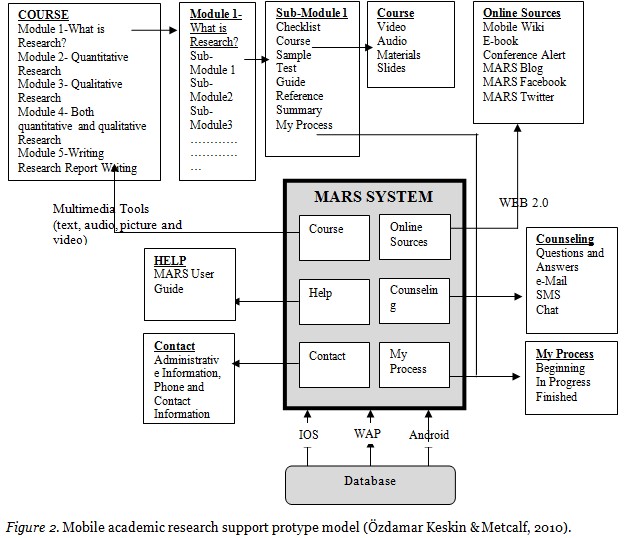
When the academics’ views about the MARS design model were examined, the findings obtained demonstrated that the academics focused more on their own needs. The theory of education puts forward that adults focus on learning the necessary information which will help them solve their problems. This finding is consistent with the principles of the theory of adult education (Knowles, 1998).
In the second phase of the design-based research, studies on the development of the prototype of MARS system were started. As can be seen in Table 4, the phases followed for the development of the m-learning system included formation of the teams, development of the content, development of the multimedia tools and development of the m-learning system.
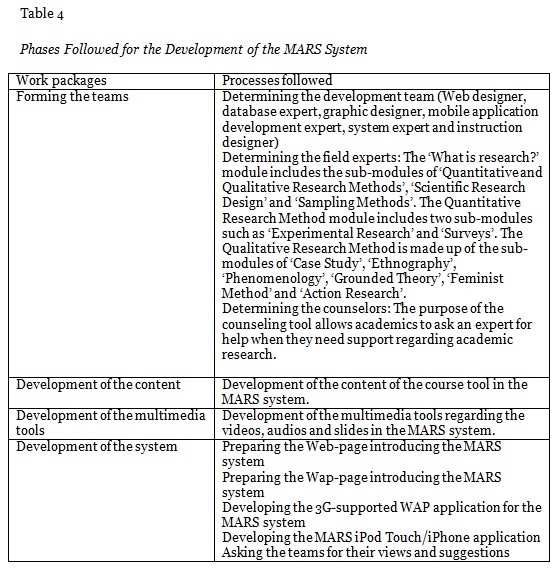
In the development process, the researcher tried to discharge such responsibilities as developing the content in the MARS system, determining the specialists, recording the videos, fictionalizing the videos, coordinating the members of the development team, testing the tools within the MARS system, overcoming the possible problems and meeting the possible needs and monitoring the job flow. Figure 3 presents the technological sub-structure of the m-learning system.
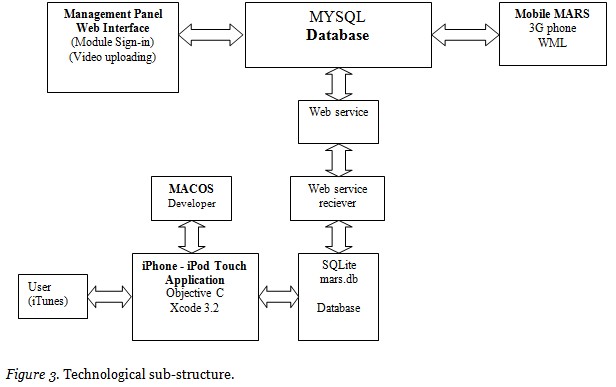
In the first phase of the development of the MARS system that served the research purposes, the database was developed with mySQL. For the MySQL database management, phpMyAdmin was used. It is a freeware that serves such functions as creating and deleting a database, adding a table, revising and deleting, adding a domain running SQL inquiries, and managing the users, authorities and the domain key. After the database of the MARS system was developed, the content management system called management panel which provided an interface to allow a database expert to upload the content to the database by using the PHP program language was developed. The MARS system is made up of five modules such as “what is research”, “quantitative method”, “qualitative method”, “mixed method” and “effective reporting”. Any information to be included in or excluded from these modules is uploaded to the database via the management panel developed. In addition, multimedia elements such as experts’ videos, audio materials and slides are uploaded to the database again with the help of this platform management.
While the database expert created the database of the system, the interface designer started developing the logo of the MARS system, its icons and its interfaces. Then, the web designer, using the HTML programming language, created a webpage for the study to introduce the MARS project. Following this, this webpage was developed as Flash-based using the Action Script programming language. In the phase following the creation of the sub-structure and introduction webpage of the system, the WAP application for the m-learning system was developed. The WAP application for the m-learning system developed for academics was designed with PHP, Ajax and JavaScript. After all the tools were designed, the WAP application for the m-learning system was re-arranged by the development team for access via mobile devices using different platforms. Following this, the application was tested with different smart phones, and the errors identified were corrected. As a result, the application was made ready for use and uploaded by the system administrator to Anadolu University servers.
The process of developing the MARS application for iPod touch devices started following the WAP application of the m-learning system. For this application, first of all, the web service was designed for the integration and synchronization between the WAP application and the mobile application. The database that would help keep such information within the mobile application as the module, sub-module and video was designed. In order for the new modules added via the web interface to be seen within the mobile application, the web service client that updated the database was developed. The interface of the MARS mobile application was developed, and the components in the interface of the mobile application and the Objective C class and methods that would connect were developed. In order to make the videos and audio files accessible, the Media.framework on iOS SDK was used. In order to make the files of pictures and slides accessible, the iMageIO library on iOS SDK was used. To update the content, the Core Network Layer and File IO on iOS SDK were used. In order to collect statistical data, a special e-mail library that would allow mailing the logs was used. After the development of all these tools, the application was tested. The application was tested with real devices following registration to the Apple Developer program and following this, the application was uploaded to the iTunes store. For the purpose of examining the logs sent during use, the necessary utility programs were developed.
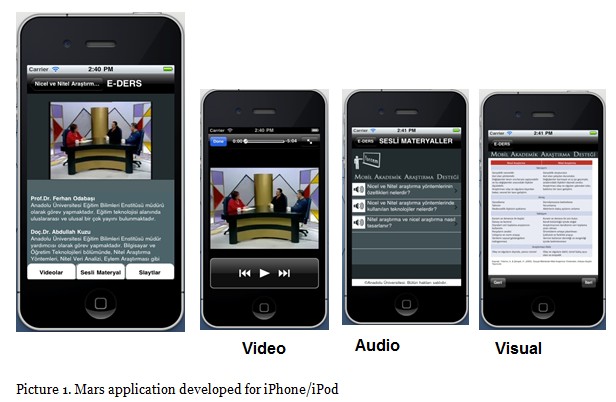
Facebook, Blog and Twitter found in online sources were used for communication and information sharing in MARS. A Facebook group page called “Mobile Academic Research Group” was created. The action research participants were added to this Facebook page. With this tool, the purpose was to share the announcements regarding the action research process and to share information, videos and links regarding scientific research methods. The MARS blog page was prepared with the WordPress tool. The blog page included information for the academics about the corrections made on the MARS system. Twitter was another WEB 2.0 tool developed to deliver the announcements to the participants regarding the research process.
The third phase of the study used action research methodology. Table 5 presents action research questions linked with study group, research duration, data collection technique, data analysis methods and outcomes. The action research process of the study started in the meeting hall of the Education Faculty of Anadolu University on the 5th of May in 2011. The meeting started with a 15-minute presentation in which the researcher gave information about the study. Within the scope of this presentation, the researcher informed the participants (15 academics from different degree levels and from different fields of social sciences such as sociology, management, distance education, education technology, communication; 10 male and 5 female) about the purpose of the study, the research questions, the action research method and about the action research process. Following this, the researcher gave information about the m-learning system applications and introduced each of the tools found in the m-learning system. The tools of SMS and Chat, which were actually developed and found within the MARS model, were not used due to the security settings of Anadolu University. For this reason, other mobile applications such as Skype, Facetime and i2i, which were not found within the MARS system, were used to establish communication with the participants and with the counselors. The participants were informed about these applications and installed these applications on their own portable media players. Participants used the application by themselves during eight weeks.
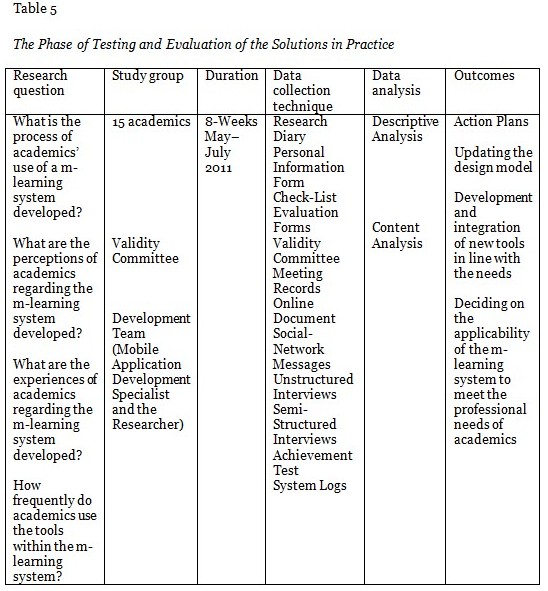
Each week, the problems with the MARS system were determined, and action decisions were made regarding these problems. Based on these decisions, action plans were put into practice, and the system was re-developed. The results of the evaluation were shared with the validity committee, and the product developed was presented to the participants. Following this, the phase of problem-determining was started again regarding the product developed. This cycle lasted eight weeks. Table 6 demonstrates the tools that the participants preferred most in the m-learning system during the action research process.
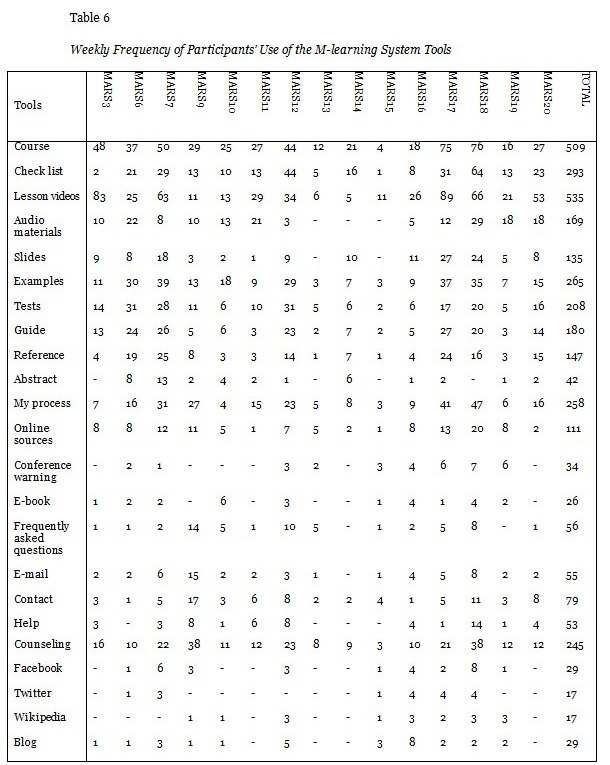
As can be seen in Table 6, the analysis of the system logs obtained from the participants revealed that the course tool was the most frequently used tool in the m-learning system and that course videos were the most frequently used course tool. The second most frequently used course tool was the tool of ‘my process’. This situation could be a result of the fact that the academics followed the learning processes regarding the course tool via the ‘my process’ tool. It was seen that among the other basic tools of the m-learning system, the counseling tool was clicked more when compared to online sources. This situation could be explained with the fact that the academics preferred the use of e-mail to that of web 2.0 tools. As the forum tool was added to the system at a later time, the data regarding the use of this tool was not analyzed. As for the help tool, it was the one clicked least. This result could be said to demonstrate that the m-learning system was easy to use.
Among the multimedia tools, the participants preferred the lesson videos most. It was found out that the audio materials were used more when compared to slides. Academics favored the checklist, samples, tests, guides and reference tools within the course tool. As for the abstract, e-book and conference warning tools were among those with low levels of frequency of use. Also, the frequency of the academics’ use of such external applications as Facebook, Twitter, Wikipedia and blog was quite low. The academics reported that they had difficulty sharing such problems as well as their needs with other academics on social media. They didn’t want to reflect their learning needs on social platform. Scientific research is a difficult and complex field open to criticism. For example, a research approach could be interpreted in a different way by academics from different disciplines. For this reason, it could be stated that web 2.0 tools were suitable for the m-learning system yet not suitable for the m-learning system developed for the professional development needs of academics in terms of scientific research. This problem may be cultural.
The results regarding the perceptions and experiences of the academics in relation to the process of the use of the m-learning system called as MARS are listed.
Academics have such responsibilities as conducting research, contributing to the science via scientific papers and training new researchers. In order to fulfill all these responsibilities, it is important for academics to access the correct information, to design and conduct a scientific study, to follow the best scientific publications and to have the awareness and knowledge necessary to evaluate the studies related to their field of study. In this respect, as an innovative solution, the m-learning system was developed since mobile technologies, today, are regarded as technologies most appropriate to professional development, new approaches in education and research (Kukulska-Hulme and Traxler, 2007; Sharples, 2000).
When the process of the use of the m-learning system was examined with respect to the achievement factors put forward by Barker, Kurull and Marrison (2005), it could be stated that the criteria of interaction, discussion and cooperation were partly met. It was observed that the academics preferred the m-learning system not for communication and interaction purposes but for the purpose of developing their professional performances and revising their background knowledge with new information. Also, the result refers Quinn’s mobile learning view including both performance support and learning (2013). In this respect, the m-learning system could be said to increase life-long learning and support individual learning (Sharples et al., 2002). It was seen that the academics avoided sharing their problems and the related questions with others on the subject of scientific research. The academics reported that others might regard this situation as academic incompetence. Therefore, these factors caused cooperation, discussion and interaction with other academics and counselors to become restricted.
Mobility is another success criterion for m-learning studies (Barker, Kurull and Marrison, 2005; Sharples, 2000). In the research process, portable media players supporting the wireless Internet were used, and mobility remained limited. However, as the overall design of the m-learning system allowed access via 3G-supported smart phones, this system could be said to be successful in terms of mobility and accessibility. Therefore, it was concluded that the features of a mobile device selected is quite important for the success of a future study to be conducted. However, in Turkey, the higher cost of mobile technologies compared to other countries makes it difficult to access mobile devices (Kıcı, 2010). Similar to the study of Handal et al. (2013), academics highlighted they would prefer to use mobile learning system such as MARS If technological infrastucture problems are solved, and the cost of both mobile devices and the Internet connection reduces in Turkey.
When the tools within the m-learning system were examined, it was seen that the lesson videos were used most. This finding obtained in the present study is consistent with that of another study conducted by Çakır (2009), who reported that learners prefer videos to the visual content.
In general, the use of the m-learning system for professional development purposes was found to provide independence of time and place to academics. It was seen that the system was portable, personal, accessible, useful, affordable, appealing, adaptable, practical, appropriate to purpose and easy to use. As the findings of the present study are in line with those of another study carried out by Sharples in 2000 that mentioned technology needs supporting life-long contextual learning, this m-learning design could be said to achieve life-long contextual learning.
In this paper, a m-learning system for the professional development of academics was developed by using the method of design based action research, and the perceptions and experiences of the academics using this system were examined. In the first phase of this design-based action research, the research question was defined. In the second phase, a m-learning system called “Mobile Academic Research Support” was designed as a solution to the problem, and the IOS mobile application for this design was developed. In the third phase of the study, the MARS application was regularly tested and evaluated by the academics over eight weeks. At the end of the research process, the results were reflected upon. It was found that the primary and important professional development needs of the academics were at the scientific research level. It was also observed that the m-learning system developed for the professional development of the academics regarding scientific research was appropriate to the overall purpose, accessible, adaptable and appealing; that it served both as a m-learning and as an academic support system; that its content was satisfactory; and that the tools used in the system were useful. In addition, it was observed that the academics were able to use mobile technologies for learning. Also, it was stated that such a system could provide positive contributions to the professional development of academics.
Based on the research results, the following suggestions could be put forward:
Ally, M. & Tsinakos, A. (2014). Introduction: Enhancing access to education with mobile learning. In M. Ally & A. Tsinakos (Eds). Increasing access through mobile learning (pp 1-7). Vancouver, Canada: Commonwealth of Learning and Athabasca University.
Andriessen, D. (2007). Combining design-based research and action research to test management solutions. 7. World Congress Action Learning, Action Research and Process Management, Groningen. Retrieved 22 September 2013, from http://www.weightlesswealth.com/downloads/Andriessen%20DBR%20and%20Action%20Research.PDF
Barker, A., Krull, G. & Mallinson, B. (2005). Proposed theoretical model for m-learning adoption in developing countries. In H. van der Merwe & T. Brown (Eds), mLearn 2005: 4th World Conference on mLearning (pp. 1–10). Cape Town, South Africa: mLearn.
Cochrane, T. (2013). M-learning as a subfield of open and distance education. In Z. L. Berge & L. Y. Muilenburg (Eds.) Handbook of mobile learning (pp. 15-24). New York, USA: Routledge Taylor and Francis Group.
Cochrane, T. D. (2014). Critical success factors for transforming pedagogy with mobile Web 2.0. British Journal of Educational Technology, 45, 65–82. doi: 10.1111/j.1467-8535.2012.01384.x
Cook, J. (2009). Phases of mobile learning. Joint European summer school on technology enhanced learning, May 30–June 6. Retrieved 16 July 2010, from http://www.slideshare.net/johnnigelcook/cook-phases-of-mobile-learning
Crompton, H. (2013a). A historical overview of m-learning: Toward learner-centered education. In Z. L. Berge & L. Y. Muilenburg (Eds.) Handbook of mobile learning (pp. 3-15). New York, USA: Routledge Taylor and Francis Group.
Crompton, H. (2013b). Mobile learning: New approach, new theory. In Z. L. Berge & L. Y. Muilenburg (Eds.) Handbook of mobile learning (pp. 47-58). New York, USA: Routledge Taylor and Francis Group
Çakır, V. (2005). Bir sosyal etkinlik olarak eğlence ve televizyon (konya örneği) [Entertainment and television as a social action: a case of konya] Selcuk University Journal of Social Science Institute, 13, 123-142.
Frohberg, D., Goth, C. ve Schwabe, G. (2009). M-learning projects: A critical analysis of the state of the art. Journal of Computer Assisted Learning, 25, 307-331.
Gery, G (1991). Electronic performance support systems: How and why to remake the workplace through the strategic application of technology. Boston: Weingarten.
Handal, B., MacNish, J. & Petocz, P. (2013). Academics adopting mobile devices: The zone of free movement. In Proceedings of the Annual Conference of the Australian Society for Computers in Learning in Tertiary Education (ASCILITE), Sydney, Australia, 1-4 December 2013. Retrieved from http://www.ascilite.org/conferences/sydney13/program/papers/Handal.pdf
Hamm, S.E., Drysdale, J. & Moore, D. (2014). Towards mobile learning pedagogy. In D. McConatha, C. Penny, J. Schugar, & D. Bolton (Eds.), Mobile pedagogy and perspectives on teaching and learning (pp. 1-20). Hershey, PA: IGI Global
Husein, A.R.H. & Nassuora, A.B. (2011). Academic attitudes towards the use of mobile phone technologies for knowledge sharing in higher education institutions: An exploratory survey. American Academic & Scholarly Research Journal, 1(1), 6-9.
Kıcı, D. (2010). Üniversite öğrencilerinin mobil öğrenmenin üniversite eğitimindeki etkisi konusundaki beklentileri üzerine bir araştırma. [International Conference On New Trends in Education and Their Implications], Antalya, Turkey. Retrieved from http://www.iconte.org/FileUpload/ks59689/File/125.pdf
Koole, M.L. (2009). A model for framing mobile learning. In M. Ally (Ed), Mobile Learning: Transforming the delivery of education and training (pp. 25-47). Edmonton, AB: Athabasca University Press.
Knowles, M. (1998). The adult learner: The definitive classic in adult education and human resource development. Huouston, TX: Gulf Publishing
Koszalka, T. A. ve Ntloedibe-Kuswani, G. S. (2010). Literature on the safe and disruptive learning potential of mobile technologies. Distance Education, 31(2), 139-157.
Kukulska- Hulme, A.ve Traxler, J. (Ed.)(2007). M-learning: A handbook for educators and trainers. London: Routledge.
Kukulska- Hulme, A. (2013). Mobile learners: Who are they and who will they become? In Z. L. Berge & L. Y. Muilenburg (Eds.) Handbook of mobile learning (145-155). New York, USA: Routledge Taylor and Francis Group
Livari, J. ve Venable, J. R. (2009). Action research and design science research - Seemingly similar but decisively dissimilar. ECIS 2009 Proceedings. Retrieved from http://aisel.aisnet.org/ecis2009/73 adresinden 21 Mayıs 2011 tarihinde alınmıştır.
Ma, Y. ve Harmon, S.W. (2009). A case study of design-based research for creating a vision prototype of a technology-based ınnovative learning environment [Elektronik versiyon]. Journal of Interactive Learning Research, 20(1), 75-93. Chesapeake, VA: AACE.
Menzi, N., Önal, N. & Çalışkan, E. (2012). Mobil Teknolojilerin Eğitim Amaçlı Kullanımına Yönelik Akademisyen Görüşlerinin Teknoloji Kabul Modeli Çerçevesinde İncelenmesi, [Investigatin Educational Researchers’ Views of Using Mobile Technologies for Educational Purposes based on Technology Acceptance Model]. Ege Education Journal, 13(1), 40-55.
Metcalf, D. (2006). Mlearning: m-learning and performance in the plam of your hand. Amherst, USA: HRD Press,Inc.
Mobithinking (2011). Global mobile statistics 2011: All quality mobile marketing research, mobile Web stats, subscribers, ad revenue, usage, trends. Retrieved from http://mobithinking.com/mobile-marketing-tools/latest-mobile-stats
Naismith, L., Lonsdale, P., Vavoula, G., and Sharples, M. (2004). Literature review in mobile technologies and learning. Bristol: NESTA FutureLab.
Park, Y. (2011). A pedagogical framework for m-learning: Categorizing educational applications of mobile technologies into four types. The International Review of Research in Open and Distance Learning, 12(2), 78-102.
Parsons, D. (2007). M-learning. In D. Taniar (Ed.), Encyclopedia of mobile computing and commerce (pp. 525-527). Monash University, Australia: IGI Global.
Quinn, C. N. (2013). A future of m-learning. In Z. L. Berge & L. Y. Muilenburg (Eds.) Handbook of mobile learning (82-95). New York, USA: Routledge Taylor and Francis Group.
Q’Malley, C., Vavoula, G., Glew, J., Taylor, J., Sharples, M. ve Lefrere, P. (2003). Guidelines for learning/teaching/tutoring/in a mobile environment. Mobilearn project. Retrieved 25 Septermber 2013, from www.mobilearn.org/download/results/guidelines.pdf
Rajasingham, L. (2011). Will m-learning bring a paradigm shift in higher education? Education Research International, 2011, pp 1-10.
Reeves, T.C. (2006). Design research from the technology perspective. In J.V. Akker, K. Gravemeijer, S.McKenney ve N. Nieveen (Eds.), Educational design research (pp. 86-109). London: Routledge.
Sharples, M. (2000). The design of personal mobile technologies for lifelong learning. Computers and Education Journal, 34, 177-193.
Sharples M., Corlett D. ve Westmancott O. (2002) The design and implementation of a m-learning resource. Personal and Ubiquitous Computing Journal, 6, pp 220–234.
Sharples, M., Taylor, J. ve Vavoula, G. (2005). Towards a theory of m-learning. Retrieved from http://www.mlearn.org.za/CD/papers/Sharples%20Theory%20of%20Mobile.pdf.htm
Sharples, M.,Taylor, J. & Vavoula, G. (2007). A theory of learning for the mobile age. In Proceeding of conference on seeing, understanding, learning in the mobile age (pp. 147-152). Budapest, Hungary.
Susman, G. I. ve Evered, R. D. (1978). An assessment of the scientific merits of action research. Administrative Science Quarterly, 23, 582.
Taylor, J.(2006). Evaluating mobile learning: What are appropriate methods for evaluating learning in mobile environments? In M. Sharples (ed.), Big issues in m-learning: Report of a workshop by the kaleidoscope network of excellence m-learning initiative (pp 24-26). UK: University of Nottingham.
Traxler, J. (2009a). Learning in a mobile age. International Journal of Mobile and Blended Learning, 1(1), 1–12.
Traxler, J. (2011). Introduction. In J. Traxler & J. Wishart (Eds.), Making mobile learning work: Case studies of practice (pp. 4-12). Bristol, UK: EsCalate Education Subject Centre: Advanced learning and teaching in education.
Uden, L. (2007). Activity theory for designing m-learning. International Journal of M-learning and Organization, 1(1), 81-102.
Wang, F. ve Hannafin, M. J. (2005). Design-based research and technology-enhanced learning environments. Educational Technology Research and Development, 53(4), 5-23.
Wingkvist, A. & Ericsson, M. (2011). Current practice in mobile learning: A survey of research method and purpose. In D. Metcalf, A. Hamilton & C. Graffeo (Eds), MLearn 2009: 8th World Conference on Mobile and Contextual Learning (pp. 103–111). Orlando, FL: The University of Central Florida.
Zurita, G., ve Nussbaum, M. (2007). A conceptual framework based on activity theory for mobile CSCL. British Journal of Educational Technology, 38(2), 211-235.
© Ozdamar Keskin and Kuzu